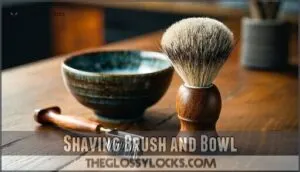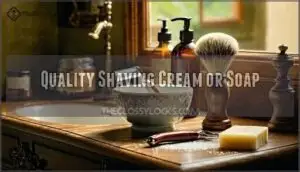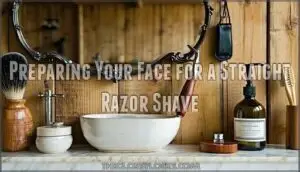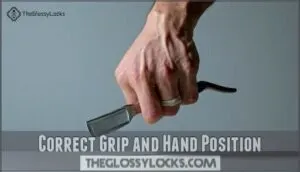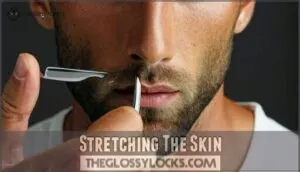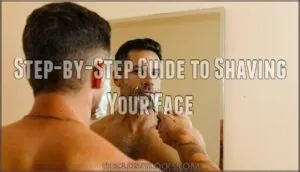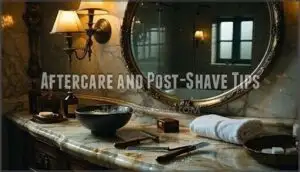This site is supported by our readers. We may earn a commission, at no cost to you, if you purchase through links.
 Shaving face with straight razor requires proper preparation and technique. Start by washing your face with hot water to soften hair, then apply pre-shave oil for protection.
Shaving face with straight razor requires proper preparation and technique. Start by washing your face with hot water to soften hair, then apply pre-shave oil for protection.
Create rich lather with a quality shaving brush and soap. Hold the razor at a 20-30 degree angle, stretch your skin tight, and shave with the grain using short, controlled strokes.
Rinse the blade frequently and take your time – rushing leads to nicks. Most beginners need two or three passes for a smooth finish.
After shaving, rinse with cold water and apply aftershave balm. Clean and dry your razor completely before storage.
The secret lies in mastering blade angle and maintaining consistent pressure throughout each stroke.
Table Of Contents
- Key Takeaways
- Why Choose a Straight Razor for Shaving
- Essential Tools for Straight Razor Shaving
- Preparing Your Face for a Straight Razor Shave
- How to Hold and Use a Straight Razor
- Step-by-Step Guide to Shaving Your Face
- Honing, Stropping, and Blade Maintenance
- Aftercare and Post-Shave Tips
- Frequently Asked Questions (FAQs)
- How to shave a straight razor?
- Why should you choose a straight razored shave?
- How do you shave your face with a razor?
- Should you use a straight razor after a shave?
- Is there an art to using a straight razor shave?
- Is straight razor shaving worth it?
- Should I shave my face with a straight razor?
- Why did people stop using straight razors?
- Does shaving with a straight razor cause acne?
- How often should I replace my straight razor?
- Conclusion
Key Takeaways
- You’ll need proper preparation and quality tools – Start with hot water, pre-shave oil, and quality shaving cream, plus invest in a good straight razor, leather strop, and shaving brush for best results.
- Master the 30-degree blade angle and controlled technique – Hold your razor at 20-30 degrees, stretch your skin tight, shave with the grain using short strokes, and let the blade’s sharpness do the work without applying pressure.
- Focus on safety over speed, especially as a beginner – Take your time, avoid rushing, rinse your blade frequently, and stick to single passes until you’ve mastered the basics to prevent nicks and cuts.
- Maintain your razor religiously for long-term success – Strop before each shave, hone when needed, clean and dry completely after use, and store in a moisture-free environment to keep your investment sharp for decades.
Why Choose a Straight Razor for Shaving
You’ve probably heard that straight razors deliver the closest shave possible, but they offer much more than just smooth skin.
From long-term savings to environmental benefits, switching to a straight razor transforms your daily routine into a mindful ritual while giving you unmatched control over your grooming.
Closer, Smoother Shave
Nothing beats a straight razor for delivering the closest, smoothest shave possible.
Experience the precision that only a single blade can deliver
You’ll slice through whiskers at skin level, eliminating stubble that safety razors leave behind.
The single blade cuts cleanly without tugging or pulling, reducing irritation while maximizing smoothness.
With proper shaving technique and blade angle, your straight razor shaving stroke becomes a precision instrument that transforms your shaving face routine.
Precision and Control
With a straight razor, you control every aspect of your shave.
You adjust the razor angle precisely, manage skin tension effectively, and maintain ideal blade sharpness through proper shaving technique.
This razor handling mastery lets you map your facial contours accurately.
Unlike multi-blade cartridges that dictate their own path, your shaving grip and technique determine the outcome completely, allowing for a more personalized and controlled shave with proper shaving technique.
Facial Health and Reduced Irritation
Proper technique with a straight razor actually promotes facial health better than multi-blade cartridges.
You’ll experience less irritation reduction when the single blade cuts cleanly without tugging.
Sensitive areas benefit from reduced razor burn since there’s no multiple-blade scraping.
Quality shaving cream and preshave oil create superior skin protection, making this traditional method gentler on sensitive skin than modern alternatives.
Cost Savings Over Time
Your wallet will thank you when you ditch those expensive cartridge refills.
Stop throwing money down the drain with expensive cartridge refills
A quality straight razor costs $100-300 upfront but delivers lifetime value through shaving cost reduction.
You’ll slash razor maintenance expenses to just stropping leather and occasional honing.
Modern cartridges cost $3-5 each, creating substantial lifetime costs.
Smart shavers recognize these long term savings add up quickly, providing a significant cost reduction.
Environmental Benefits
Beyond saving money, you’re making a smart choice for the planet.
Sustainable shaving with a straight razor eliminates thousands of disposable cartridges from landfills over your lifetime.
- Zero plastic waste from cartridge refills and packaging
- No aerosol cans polluting the atmosphere with propellants
- Minimal manufacturing footprint compared to mass-produced disposables
- Decades of use from one quality razor versus constant replacements
- Natural soap options reduce chemical runoff into water systems
This environmentally friendly shaving method aligns perfectly with green living principles.
You’ll drastically reduce your shaving environmental impact while embracing minimalism in your grooming routine.
By choosing eco friendly shaving razors options, you support sustainable materials that reduce waste and minimize harm to the environment.
Meditative and Nostalgic Experience
Your daily routine transforms into a mindful shaving ritual when you pick up that gleaming blade.
Each deliberate stroke demands your complete attention, washing away morning stress like warm lather.
This vintage grooming practice connects you to generations past, where razor craftsmanship mattered.
The meditative routine creates nostalgic feelings, turning ordinary grooming into shaving mindfulness that centers your day.
Essential Tools for Straight Razor Shaving
Getting the right tools is like having a well-stocked toolbox before tackling any serious project.
You’ll need six essential items to transform your straight razor shaving from frustrating fumbles into smooth, professional results.
Choosing The Right Razor
How do you pick the perfect straight razor from hundreds of options?
Start with carbon steel blades—they’re found in 70% of premium models for superior sharpness.
Choose 5/8" width for beginners, as it accounts for 60% of first purchases.
Round points offer safety, while resin handles provide durability and water resistance.
The quality of a straight razor is often determined by its carbon steel properties, which include superior sharpness and are typically found in premium models.
Honing Stones and Sharpeners
Sharp tools make all the difference in straight razor shaving. Your blade needs proper maintenance through honing to stay razor-sharp and safe for daily use.
Essential honing equipment includes:
- Whetstone or ceramic hone – Natural Arkansas stones or synthetic ceramics work best for sharpening
- Proper blade angles – Maintain consistent 15-20 degree angles during edge refinement
- Lubrication system – Water or oil keeps the stone clean during sharpening techniques
To achieve superior results, understanding sharpening techniques is vital for maintaining a sharp edge.
Leather Strop and Maintenance Gear
Your leather strop keeps your straight razor sharp between honing sessions.
Choose a quality strop with both canvas and leather sides – canvas removes microscopic debris while leather polishes the blade.
Proper stropping technique involves light pressure and smooth strokes away from the cutting edge.
A hanging strop with sturdy hardware works best for consistent razor maintenance and superior shaving performance.
Shaving Brush and Bowl
Your shaving brush and bowl work together like a lather-making dream team. A quality badger hair brush creates rich, creamy lather that lifts whiskers and protects skin during your shave.
- Brush Materials: Badger hair offers superior water retention and lathering compared to synthetic alternatives
- Bowl Sizes: Choose a bowl wide enough for comfortable swirling motions without splashing lather everywhere
- Handle Designs: Ergonomic handles provide better grip control when building that perfect lather consistency
Quality Shaving Cream or Soap
Quality shaving cream or soap forms the foundation of exceptional lather creation.
Traditional soap types deliver superior cushioning while modern cream benefits include easier mixing.
Choose products based on your skin conditions – sensitive skin needs glycerin-rich formulas.
Premium options offer diverse fragrance options from sandalwood to citrus.
Your shaving brush transforms any shaving soap into protective lather within your shaving bowl.
For best results, consider using high quality shaving cream products to enhance your shaving experience.
Pre-Shave Oils and Hot Towels
Before you apply lather, proper Pre-Shave Prep sets the foundation for success.
A hot towel opens pores and provides Facial Warmth that softens whiskers naturally.
Apply preshave oil afterward for enhanced Skin Softening and lubrication.
This shaving preparation routine creates Oil Benefits that protect your skin while the razor glides smoothly.
Think of it as warming up before exercise—your face care matters.
Preparing Your Face for a Straight Razor Shave
Proper face preparation is the foundation of a safe, comfortable straight razor shave.
You’ll need to soften your facial hair and open your pores to prevent nicks and achieve that smooth finish you’re after.
Washing and Softening Facial Hair
Warm water transforms stubborn whiskers into cooperative strands.
Start your facial hair prep by washing with a gentle cleanser for 30 seconds—this softening technique swells hair shafts and opens pores.
The heat makes coarse beards manageable, while skin cleansing removes oils that block shaving cream effectiveness.
Proper beard prep reduces irritation by 50% and improves hair follicle care for smoother face shaving.
Using a good shaving skincare routine is essential for achieving the best results.
Applying a Hot Towel
After washing, grab a clean towel and soak it in hot water.
Wring out excess moisture, then press it against your face for thirty seconds.
This essential skin preparation step opens pores and achieves facial softening, making whiskers more pliable.
The hot towel creates ideal facial relaxation before your straight razor shaving routine begins.
Using Pre-Shave Oil
Why skip this essential step? Pre shave oil acts as your secret weapon for straight razor success.
This shaving face essential creates a protective barrier that boosts razor glide while providing facial hydration. The oil benefits include reduced friction and enhanced skin prep.
Apply a few drops before your shaving cream to transform your blade into a smooth operator, making those shaving tips actually work, with benefits including reduced friction and facial hydration.
Creating and Applying Lather
Quality lather creation transforms your straight razor experience from rough to remarkable.
Load your shaving brush with warm water, then work it into your shaving cream or soap using circular motions.
Build rich, protective lather through proper brush techniques.
Apply the creamy mixture evenly across your face, ensuring complete coverage.
This essential soap making process creates the slick barrier your blade needs for safe passage, providing a remarkable shaving experience.
How to Hold and Use a Straight Razor
Holding a straight razor correctly is the key to a safe, smooth shave—don’t worry, you won’t need a surgeon’s steady hand.
With the right grip and angle, you’ll avoid nicks and feel like a pro in no time.
Correct Grip and Hand Position
Hold your straight razor with thumb behind the shoulder and heel.
Place index and middle fingers on the shank, wrapping your ring finger over the tang for balance.
Your pinky rests on the razor handle for control.
This grip keeps your wrist movement steady during shaving strokes.
Practice this hand position before your first shave—it’s like learning to hold a fountain pen properly.
Adjusting The Blade Angle
Once you’ve mastered the grip, blade angle control becomes your key to shaving success.
Position your straight razor at 20-30 degrees against your skin—imagine two coins stacked between the cutting edge and your face.
This angle adjustment guarantees proper shave technique while maximizing razor sharpness.
Angles above 35 degrees increase cut risk, while shallow angles won’t effectively remove whiskers.
Practice maintaining consistent shaving strokes with this ideal razor angle to achieve shaving success.
Stretching The Skin
Proper skin tension transforms your shave from dangerous to smooth.
Pull your skin taut with your free hand before each stroke.
Tight skin creates a flat shaving surface, helping the razor glide effortlessly.
Loose skin bunches under the blade, causing nicks and uneven cuts.
Use your fingertips to stretch facial areas – this simple technique dramatically improves razor control and shaving safety.
Safety Tips for Beginners
Start slow and let the razor safety principles guide you.
Never rush your first shaves—blade angle mistakes and poor shave prep cause most cuts.
Keep that thirty-degree angle consistent and avoid applying pressure.
Your safety razor skills won’t transfer directly, so practice cut prevention by going with the grain only.
Focus on skin care over closeness initially, and avoid making shaving mistakes by attempting aggressive techniques too early.
Step-by-Step Guide to Shaving Your Face
Now you’re ready to put everything together and actually shave your face with confidence.
This is where your preparation pays off, so take your time and focus on smooth, controlled movements throughout the process.
Shaving With The Grain
After mastering your grip, shaving with the grain becomes your foundation for safety and comfort.
The grain direction follows your hair’s natural growth pattern, which varies across your face.
- Map your facial terrain – Run fingers upward to feel resistance and identify growth patterns
- Angle the blade at 30 degrees, letting gravity assist your downward strokes
- Maintain skin tension by stretching with your free hand for ideal razor glide
- Follow natural flow from sideburn to jawline in smooth, controlled movements
- Rinse frequently to clear whiskers and maintain blade efficiency
Techniques for Cheeks, Jaw, and Neck
Each facial area needs different blade control.
For cheek shaving, work downward from ear to nose with gentle pressure.
At the jaw angle, roll your wrist slightly to follow the contour.
Neck strokes require extra caution—stretch skin upward and shave with short, light passes.
Proper skin stretching creates a flat surface for clean cuts.
To achieve superior results, understanding smooth skin secrets is essential for mastering the art of face shaving with smooth skin.
Navigating Chin and Upper Lip
The chin and upper lip demand your sharpest focus.
Pull your upper lip down over your teeth to create a flat surface.
Hold the straight razor at a slight angle and use short, controlled strokes.
For chin shaving, stretch the skin tight with your free hand.
These facial contours require patience—rushing here guarantees nicks.
Follow the natural grain direction carefully.
Should You Do Multiple Passes?
Most beginners benefit from single-pass shaving with straight razors.
Multiple passes increase skin irritation risks and require advanced technique.
Your razor sharpness determines shave quality more than multiple strokes.
If you missed spots, apply fresh lather and make gentle touch-ups rather than full second passes.
Focus on perfecting your first pass before attempting multiple passes in straight razor shaving.
Rinsing and Cleaning The Blade
Every few strokes, rinse your straight razor under hot water to clear whiskers and lather buildup.
This blade sanitizing keeps cuts clean and maintains shaving safety. Hot water temperature works best for razor cleaning, dissolving soap residue effectively.
After your final pass, rinse thoroughly and dry the razor blade completely using proper drying techniques before applying storage methods for superior blade maintenance and razor care.
Honing, Stropping, and Blade Maintenance
Your straight razor is only as good as its edge, and proper maintenance will keep it performing like new for decades.
You’ll master three essential skills: honing to sharpen the blade, stropping to maintain its edge, and proper storage to prevent damage.
How to Hone a Straight Razor
Your straight razor loses its keen edge with use, making regular honing necessary for peak performance.
Start with coarse 1000-grit honing stones, then progress through finer grits up to 10,000 for polishing.
Lay the blade flat with both edge and spine touching the stone. Use gentle, edge-leading strokes without pressure—let the razor’s weight do the work.
This blade maintenance keeps your straight edge sharp. To achieve the best results, understanding the proper sharpening techniques is essential for maintaining a sharp razor.
How to Strop a Straight Razor
Stropping your straight razor between shaves maintains blade alignment and sharpness without removing steel like honing does.
Pull your leather strop taut, then draw the blade spine-first along its length using light pressure.
Complete 15-20 passes on each side, flipping the razor over the spine.
This essential maintenance keeps your edge razor-sharp for smooth shaves.
Safe Blade Storage
After stropping, proper storage keeps your razor in top condition.
Moisture is carbon steel’s worst enemy, so follow these storage steps religiously:
- Blade Sanitizing: Clean with alcohol after each use
- Dry Storage: Store in a moisture-free environment away from bathroom steam
- Blade Oil: Apply camellia oil for rust prevention during long-term storage
Your razor’s longevity depends on these habits.
Think of it as tucking your blade in for a good night’s sleep.
Aftercare and Post-Shave Tips
Once you’ve finished shaving, proper aftercare guarantees your skin stays healthy and your razor remains in top condition.
These final steps protect both your face and your investment in quality shaving tools.
Rinsing and Soothing The Skin
Immediately rinse your face with cold water to contract pores and reduce irritation by 60%.
The cold compress effect calms inflamed skin and stops minor bleeding faster.
Pat dry gently with a clean towel—rubbing creates microtears.
This simple skin care step sets you up perfectly for moisturizing and aftershave application.
Applying Aftershave or Balm
The final step transforms your freshly shaved face from raw canvas to comfortable masterpiece.
Choose your weapon wisely:
- Aftershave Benefits: Tightens pores and prevents bacteria from causing infections
- Balm Ingredients: Look for aloe vera, witch hazel, or glycerin for superior Skin Soothing
- Razor Burn: Combat irritation with alcohol-free formulas that won’t sting
- Facial Moisturizing: Apply postshave products to lock in hydration and promote healing
When selecting a product, consider the Aftershave Balm properties that suit your skin type.
Cleaning and Drying The Razor
Right after stropping comes the vital step of razor sanitizing and blade drying.
Rinse your straight razor under warm water to remove all lather and whiskers. Pat it completely dry with a clean towel—moisture is rust’s best friend.
Use cleaning solutions like isopropyl alcohol for thorough sanitization. Proper drying techniques prevent corrosion and maintain your blade’s edge for future shaves.
Regular maintenance involves understanding the importance of a clean razor routine to guarantee superior performance.
Storing Your Straight Razor Properly
Your straight razor deserves better than a kitchen drawer. After cleaning and drying, proper razor storage protects your investment and maintains peak performance.
- Choose a dry environment – Moisture kills razor sharpness faster than a dull conversation
- Apply camellia oil to the blade surface for rust prevention and longevity
- Store blade open in a protective case away from humidity sources
- Keep away from shower steam – your bathroom isn’t always razor-friendly
- Check monthly for any signs of corrosion or damage during storage
Frequently Asked Questions (FAQs)
How to shave a straight razor?
Hold your razor at 30 degrees, shave with the grain using short strokes, keep skin taut, rinse blade frequently, and let the sharp edge do the work—no pressure needed.
Why should you choose a straight razored shave?
You’ll enjoy sharper cuts, smoother skin, and deeper satisfaction. Straight razors deliver precision multi-blade cartridges can’t match. They’re cost-effective, eco-friendly, and transform daily grooming into mindful craftsmanship that builds confidence.
How do you shave your face with a razor?
Start with a clean face and sharp blade. Hold the razor at 30 degrees, shave with the grain using light pressure and short strokes. Keep skin taut and rinse frequently.
Should you use a straight razor after a shave?
No, you shouldn’t use a straight razor after completing your shave. Post-shave care involves rinsing with cool water, applying aftershave or balm, and properly cleaning your razor for storage.
Is there an art to using a straight razor shave?
Like a maestro conducting a symphony, mastering the straight razor requires patience, precision, and respect for the blade’s unforgiving edge—it’s pure artistry demanding steady hands and focused mind.
Is straight razor shaving worth it?
Straight razor shaving delivers superior results but demands serious commitment. You’ll get closer shaves, save money long-term, and enjoy the ritual. However, expect months mastering technique and daily maintenance routines.
Should I shave my face with a straight razor?
You’ll get exceptional results if you commit to learning proper technique, but it demands patience and practice. The steep learning curve means cuts and nicks while mastering this traditional craft.
Why did people stop using straight razors?
Safety razors revolutionized shaving around 1901 – King Gillette’s invention offered convenience without the skill and daily maintenance that straight razors demanded, making quick grooming accessible to everyone.
Does shaving with a straight razor cause acne?
Proper straight razor technique actually reduces acne by preventing irritation and ingrown hairs. However, poor technique, dirty blades, or inadequate prep can worsen breakouts through bacterial contamination and skin trauma.
How often should I replace my straight razor?
Unlike disposable razors, you’ll never need to replace a quality straight razor. With proper care, honing, and stropping, your blade will last generations. It’s an investment that pays dividends forever.
Conclusion
Mastering shaving face with straight razor isn’t just tradition—it’s proven technique that delivers superior results when executed properly.
You’ve learned the seven essential steps that transform novices into confident shavers.
Remember, patience beats speed every time. Your first few shaves might feel awkward, but muscle memory develops quickly.
Most guys achieve smooth results within two weeks of consistent practice. Keep your blade sharp, your technique steady, and your expectations realistic.
With proper preparation and controlled movements, you’ll soon enjoy the closest shave possible.




